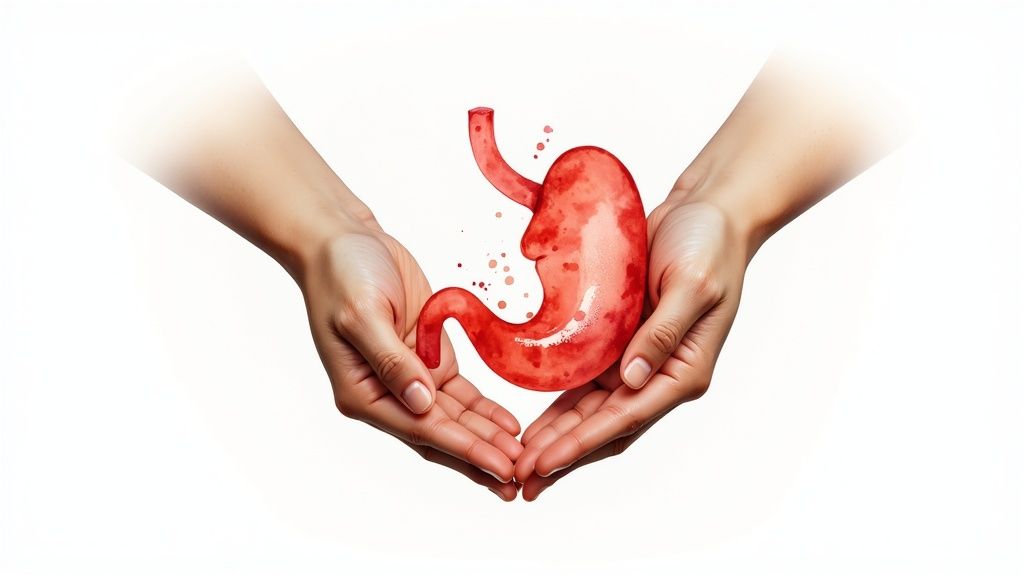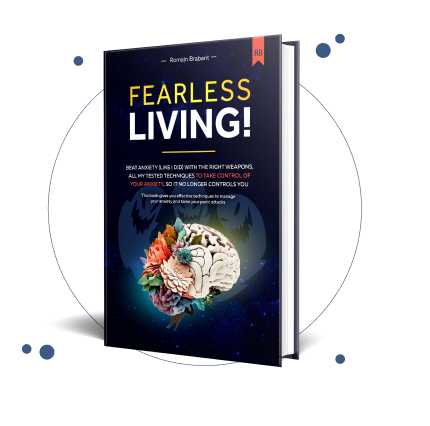
When we picture a panic attack, we often imagine hyperventilation, shaking, or crying. But what about the attacks that no one else can see? These episodes unfold internally, a storm of physiological and cognitive distress hidden behind a mask of calm. You might be sitting in a meeting, driving your car, or talking to a friend, all while an intense battle rages within. This is the reality of silent panic attack symptoms.
Understanding these hidden signals is the first, most powerful step toward regaining control and finding lasting peace. While the experience can feel incredibly isolating, recognizing that these internal shifts are legitimate symptoms of panic provides a crucial foundation for healing. The body's intricate systems are deeply interconnected; for instance, to gain a deeper understanding of the complex interplay between physical and mental well-being, it's insightful to explore how endocrine disorders can impact mental health.
This guide is designed to illuminate these unseen struggles, from a racing heart that feels like it’s about to burst to the disorienting wave of dizziness that hits without warning. We will break down six common yet often overlooked symptoms, offering not just descriptions but actionable strategies for recognition and management. This knowledge is more than just information; it's the start of your journey toward a life where you are in control, offering tangible hope that healing from panic is not just possible, but achievable.
1. Racing Heart and Cardiovascular Changes
One of the most profound and frightening silent panic attack symptoms involves sudden cardiovascular changes. Internally, your heart may begin pounding furiously against your ribs, a condition known as tachycardia. This happens because your body’s alarm system, the fight-or-flight response, floods your system with adrenaline, preparing you to face a perceived threat even when there is no external danger. The experience is intensely physical, yet completely invisible to others.

These sensations often go beyond a simple rapid pulse. You might feel heart palpitations, which can feel like fluttering, skipping a beat, or a sudden, forceful thump in your chest. This can be accompanied by a feeling of tightness or pressure, which is often mistaken for a heart attack, escalating the internal panic. While these symptoms are distressing, understanding their origin is the first step toward regaining control and realizing that you can manage and overcome these episodes. For a deeper dive into the mechanics behind this reaction, you can learn more about the body's natural defense system in this comprehensive guide to the fight-or-flight response.
How to Recognize and Respond
Recognizing these cardiovascular changes as a symptom of a silent panic attack, rather than a medical emergency, is a crucial skill that brings immense relief. The key difference is often the context; panic-induced symptoms typically arise alongside other anxiety feelings and subside within 20-30 minutes, whereas cardiac events may have different accompanying signs.
Key Insight: Your heart is a strong, resilient muscle. A racing heart during a panic attack is a sign of your body's powerful but miscalibrated survival system, not a sign of cardiac weakness. Healing is possible, and you can learn to live panic-free.
Actionable Coping Strategies
When you feel your heart begin to race, you are not powerless. Here are immediate, actionable steps you can take to calm your cardiovascular system:
- Practice 4-7-8 Breathing: Inhale quietly through your nose for a count of 4, hold your breath for a count of 7, and exhale completely through your mouth for a count of 8. This technique directly engages your parasympathetic nervous system, which helps slow your heart rate.
- Utilize the Valsalva Maneuver: Gently pinch your nose, close your mouth, and try to exhale as if you are blowing up a balloon. Hold for just a few seconds. This simple action can stimulate the vagus nerve, which helps regulate and often reset your heart’s rhythm.
- Keep a Symptom Diary: Note when your heart races, what you were doing, and what you were thinking. Over time, this log will reveal patterns and triggers, empowering you to anticipate and manage episodes before they escalate. It’s a powerful tool for self-awareness and your healing journey.
2. Shortness of Breath and Respiratory Distress
Another hallmark of silent panic attack symptoms is the sudden onset of respiratory distress. This can manifest as a terrifying feeling of being unable to catch your breath, a sensation of suffocation, or a tightness constricting your airway. The body’s fight-or-flight response is once again the culprit, causing your breathing to become rapid and shallow (hyperventilation) to maximize oxygen intake for a non-existent threat. Outwardly, you might appear completely calm, yet internally, you are battling a profound sense of air hunger.

This experience is isolating. A student might feel breathless during an exam while showing no external signs of distress, or a professional might maintain composure in a meeting while feeling as if they are suffocating. This internal struggle can amplify the panic, as the physical symptoms feed the fear that something is terribly wrong. However, recognizing this as a common anxiety symptom is a powerful step toward reclaiming control and building a panic-free life. For more structured guidance, you can explore these powerful breathing exercises for anxiety.
How to Recognize and Respond
Distinguishing between panic-induced breathlessness and a true medical emergency is key to de-escalating the fear. Panic-related respiratory symptoms are often accompanied by other anxiety signs (like racing thoughts or tingling) and will typically resolve as the panic subsides. It’s a physiological overreaction, not a failure of your lungs. Learning to identify this pattern helps break the cycle of fear and shows you that recovery is within reach.
Key Insight: Your urge to gasp for air is a trick of the anxious mind. Your body is actually getting too much oxygen, not too little. By focusing on slowing down your breath, you can find relief and prove to yourself that you are in control. You have the power to heal and live a life free from panic.
Actionable Coping Strategies
When you feel your breathing quicken and tighten, you can take immediate action to restore balance. These techniques are designed to regulate your respiratory system and calm your nervous system, reminding you that you can manage these feelings:
- Focus on the Exhale: Instead of trying to force a deep inhale, which can worsen hyperventilation, concentrate on a slow, complete exhale. Purse your lips and breathe out steadily for as long as feels comfortable. The inhale will follow naturally.
- Practice Diaphragmatic (Belly) Breathing: Place one hand on your chest and the other on your belly. Breathe in slowly through your nose, allowing your belly to expand outward while your chest remains relatively still. This engages the diaphragm and activates the calming parasympathetic nervous system.
- Carry a Small Paper Bag: If you are hyperventilating, breathing into a small paper bag for a minute can help restore the proper balance of carbon dioxide in your blood, quickly alleviating symptoms like dizziness and tingling. Use this technique sparingly and only for brief periods.
3. Dizziness, Lightheadedness, and Spatial Disorientation
Another profoundly disorienting silent panic attack symptom is the sudden onset of vestibular and neurological sensations. Internally, you might feel a wave of dizziness, a sense of lightheadedness as if you're about to faint, or a strange feeling of unreality. This occurs because the fight-or-flight response can alter blood flow to the brain and affect the inner ear's balance system, all while you may appear completely normal to an outside observer. The experience is deeply physical and can leave you feeling unstable and insecure in your own body.

These feelings often extend beyond simple dizziness into more complex experiences like derealization, where the world around you feels foggy, dreamlike, or distorted. You might also experience depersonalization, the unsettling sensation of being detached from yourself, as if observing your own actions from a distance. These symptoms amplify the internal fear, creating a vicious cycle of panic. Recognizing that these sensations are a temporary byproduct of anxiety, not a sign of losing your mind, is a critical step toward healing and regaining a sense of stability. For an in-depth guide on reconnecting with the present moment, explore these powerful grounding techniques for anxiety.
How to Recognize and Respond
Learning to identify these sensations as part of the panic-anxiety spectrum is key to de-escalating the fear. Panic-induced dizziness is often accompanied by other anxiety symptoms like a racing heart or shortness of breath and typically resolves as the panic subsides. In contrast, other medical causes of vertigo might have different triggers or patterns. Attributing the feeling to anxiety breaks its power over you and opens the door to healing.
Key Insight: The sensations of dizziness and detachment are your nervous system's temporary overreaction, not a permanent state. You can anchor yourself back to reality and build a life where you feel present, stable, and free from panic.
Actionable Coping Strategies
When you feel dizzy or disconnected, you can take immediate, targeted action to ground yourself and restore your sense of balance. Every time you use these tools, you are building the skill of self-regulation:
- Practice the 5-4-3-2-1 Grounding Method: Name five things you can see, four things you can touch, three things you can hear, two things you can smell, and one thing you can taste. This technique pulls your focus away from internal sensations and firmly into the present moment.
- Maintain Steady Blood Sugar: Low blood sugar can mimic or worsen feelings of lightheadedness. Eating small, balanced meals and snacks throughout the day helps keep your glucose levels stable, reducing the likelihood of this physical trigger.
- Avoid Sudden Movements: When you feel an episode starting, try to sit down. Avoid standing up or changing positions too quickly, as this can exacerbate feelings of dizziness and unsteadiness. Give your body a moment to re-calibrate.
4. Gastrointestinal Distress and Digestive Symptoms
The powerful gut-brain connection means that your digestive system often becomes an internal battleground during a silent panic attack. As the fight-or-flight response diverts blood away from the digestive tract to your major muscles, it can trigger a cascade of uncomfortable gastrointestinal symptoms. You might experience sudden, intense nausea, a churning or cramping stomach, or an urgent need to use the bathroom, all while maintaining a calm outward appearance. These physical sensations are very real and distressing, making them a common yet invisible sign of inner turmoil.

This internal chaos can manifest in various ways, from a complete loss of appetite to sharp abdominal pains that add another layer of fear to the experience. For example, a parent might feel waves of nausea while sitting calmly through a child's doctor's appointment, or a student might feel an overwhelming urge to find a restroom just minutes before a major presentation. Recognizing that these gut feelings are linked to anxiety, not a separate illness, is a crucial step. Understanding this connection allows you to address the root cause and learn how certain lifestyle and diet changes can support your journey to wellness in our guide to managing anxiety through diet.
How to Recognize and Respond
Learning to identify these digestive issues as one of the key silent panic attack symptoms can prevent you from spiraling into further anxiety about your physical health. A key indicator is the timing; these symptoms often spike during periods of high stress or anticipation and tend to fade as the anxiety subsides. Unlike a stomach bug, panic-related GI distress is directly tied to your mental state.
Key Insight: Your gut is often called the "second brain" for a reason. The discomfort you feel is a direct signal from your nervous system, not a sign of a permanent digestive disorder. By calming your mind, you can also soothe your stomach and find lasting relief and healing.
Actionable Coping Strategies
When you feel your stomach begin to churn, you can take immediate steps to regain a sense of calm and control. Here are effective strategies to manage these symptoms and support your well-being:
- Practice Abdominal Breathing: Place a hand on your stomach and breathe in slowly and deeply, feeling your belly expand. Exhale slowly. This deep, diaphragmatic breathing activates the vagus nerve, which helps calm the gut-brain axis and ease digestive distress.
- Use Natural Soothers: Keep items like peppermint tea, ginger chews, or chamomile tea on hand. These have natural anti-nausea and calming properties that can provide quick physical relief and create a comforting ritual during an episode.
- Identify Food Triggers: Keep a simple log of what you eat and how you feel. You may discover that certain foods, like caffeine, sugar, or highly processed items, worsen your anxiety-related gut symptoms. Avoiding these triggers can significantly reduce their frequency and intensity, giving you more control.
5. Temperature Regulation Issues and Physical Sensations
Another intensely physical yet invisible symptom of a silent panic attack is a sudden and dramatic shift in body temperature. The body’s fight-or-flight response reroutes blood flow to major muscle groups, disrupting your internal thermostat. This can manifest as an intense hot flash that makes you feel like you are burning up from the inside out, even in a cool environment. Conversely, you might experience sudden chills or cold sweats that leave your skin clammy and cool despite feeling internally agitated.
These sensations are disorienting and add another layer of distress to the silent panic attack. A person might be sitting in a routine work meeting, maintaining a calm exterior, while internally battling a wave of overwhelming heat. Another common scenario is feeling suddenly overheated and flushed while shopping in an air-conditioned store. These confusing physical feelings can amplify the sense of losing control, but knowing what they are is the first step to managing them and finding peace.
How to Recognize and Respond
Learning to identify these temperature fluctuations as silent panic attack symptoms is a powerful step. The key is recognizing that these sensations are a physiological byproduct of adrenaline, not a sign of a fever or external environmental change. They typically arise suddenly, peak with other internal anxiety symptoms, and then subside as the panic episode passes, often within minutes. This understanding gives you power over the experience.
Key Insight: Your body's temperature regulation is temporarily hijacked by your survival instincts during a panic attack. This is a normal, albeit uncomfortable, part of the process. With practice, you can learn to soothe this response and find your way back to balance and a life free from panic.
Actionable Coping Strategies
When you feel these temperature shifts begin, you have practical tools to regain a sense of equilibrium. Here are immediate, actionable steps to help manage these physical sensations and feel more in control:
- Dress in Layers: This simple, proactive strategy allows you to quickly adapt. If a hot flash hits, you can remove a sweater or jacket to cool down instantly. If you feel a chill, you can add a layer back on.
- Use Temperature Grounding: Apply a cold stimulus to key pulse points. Run your wrists under cold water or press a cool water bottle to your neck or forehead. The stark temperature contrast can help ground you in the present moment and short-circuit the panic response.
- Practice Cooling Breath: A simple breathing technique can help regulate your internal temperature. Inhale slowly through your nose, and then exhale even more slowly through pursed lips, as if you are gently blowing out a candle. This helps calm the nervous system and creates a cooling sensation.
6. Muscle Tension, Trembling, and Physical Rigidity
Another common yet often overlooked silent panic attack symptom is the sudden onset of intense muscular distress. During a silent attack, your body's fight-or-flight response prepares you for physical action, causing muscles to involuntarily tighten and brace for impact. This can manifest as widespread muscle tension, subtle trembling in your hands or legs, persistent jaw clenching, or an overall feeling of physical rigidity, all while you maintain a calm outward appearance.
These physical symptoms can cause significant discomfort, soreness, and profound fatigue, yet remain completely hidden. For instance, an employee might sit perfectly still through a meeting, appearing focused while their shoulders are painfully tensed up to their ears. Similarly, someone might grip their steering wheel with white knuckles during a routine drive, their body locked in a rigid posture due to an internal surge of anxiety. Recognizing this tension is key to releasing it and moving towards a more relaxed state of being. For those dealing with chronic tension from anxiety, exploring therapeutic options can be a critical step. You can learn more about psychotherapy for anxiety and how it addresses these physical manifestations.
How to Recognize and Respond
Learning to identify this muscular response as a sign of silent panic is empowering. The tension is often a direct physical translation of internal stress. You might first notice a dull ache in your neck, realize your jaw is sore from clenching, or see a slight, uncontrollable tremor in your hand as you try to write. These are not random pains but signals from your nervous system that you can learn to manage.
Key Insight: Your body is not betraying you; it is trying to protect you based on a misread signal of danger. This physical tension is a byproduct of that powerful protective instinct. You have the ability to soothe this response and teach your body it is safe, paving the way for a panic-free life.
Actionable Coping Strategies
When you feel your muscles start to tense and tremble, you can take immediate action to regain a sense of ease and control. Each of these strategies is a step toward healing:
- Practice Progressive Muscle Relaxation (PMR): Systematically tense a specific muscle group (like your hands) for 5 seconds, then completely release the tension for 10 seconds, focusing on the feeling of relaxation. Work your way through different muscle groups from your feet to your head to release tension throughout your body.
- Use a Fidget Tool or Stress Ball: Channel the nervous energy causing your muscles to tense into a physical object. Squeezing a stress ball or manipulating a fidget tool can provide a safe, focused outlet for the physical agitation, preventing it from building up in your larger muscle groups.
- Apply Targeted Heat Therapy: Place a warm compress or heating pad on areas of significant tension, such as your neck, shoulders, or lower back. The heat helps increase blood flow and relax the tight, sore muscles, providing immediate physical relief from this silent panic attack symptom.
Silent Panic Attack Symptoms Comparison
| Aspect | Racing Heart and Cardiovascular Changes ⭐🔄⚡📊💡 | Shortness of Breath and Respiratory Distress ⭐🔄⚡📊💡 | Dizziness, Lightheadedness, and Spatial Disorientation ⭐🔄⚡📊💡 | Gastrointestinal Distress and Digestive Symptoms ⭐🔄⚡📊💡 | Temperature Regulation Issues and Physical Sensations ⭐🔄⚡📊💡 | Muscle Tension, Trembling, and Physical Rigidity ⭐🔄⚡📊💡 |
|---|---|---|---|---|---|---|
| Implementation Complexity 🔄 | Moderate; requires awareness of heart symptoms and breathing techniques | Moderate; involves respiratory control practices | Moderate; needs grounding and posture management | Moderate; involves dietary and breathing adjustments | Moderate; requires environmental and breathing management | Moderate; daily muscle relaxation and physical therapy suggested |
| Resource Requirements ⚡ | Low; breathing exercises and symptom diary | Low; breathing techniques and paper bag for rebreathing | Low; grounding tools and steady environment | Low; dietary modifications and herbal remedies | Low; cooling/warming supplies and clothing layers | Low; stress tools, heat therapy, and occasional therapy |
| Expected Outcomes 📊 | Reduced heart rate spikes and better symptom control | Improved breath regulation and reduced hyperventilation | Decreased dizziness episodes and improved spatial orientation | Alleviated nausea and digestive discomfort | Stabilized body temperature and reduced sweating/chills | Reduced muscle tension and tremors, improved relaxation |
| Ideal Use Cases 💡 | Individuals with sudden tachycardia and chest sensations | Those experiencing unnoticed breathing difficulties | People prone to dizziness and sensory disorientation | Persons with anxiety-induced stomach issues | Individuals with sudden temperature swings during stress | Those with chronic muscle stiffness and involuntary trembling |
| Key Advantages ⭐ | Helps distinguish panic from cardiac issues; easy self-monitoring | Teaches controlled breathing; portable calming aids | Supports sensory grounding; enhances safety | Addresses gut-brain axis; natural symptom relief options | Provides quick temperature relief; adaptable in daily settings | Promotes physical comfort; reduces secondary pain conditions |
Your Path to a Panic-Free Life Begins Now
Understanding the intricate and often misunderstood nature of silent panic attack symptoms is the first, most crucial step toward regaining control. The journey you've just taken through this article, exploring everything from a racing heart to sudden temperature shifts and muscle rigidity, is more than just an exercise in information gathering. It is an act of empowerment. You are equipping yourself with the knowledge to translate confusing physical signals into a clear message from your body.
For too long, you may have felt isolated or confused, wondering if these intense internal experiences were “real” or just “in your head.” Let this be your validation: they are real, they are physiological, and you are not alone in experiencing them. Recognizing that shortness of breath, dizziness, or gastrointestinal distress can be core components of a panic attack demystifies the experience, stripping it of its power to cause secondary fear and confusion.
From Recognition to Lasting Relief
The ultimate goal is not just to survive these moments but to build a life where they no longer dictate your choices. Mastering the ability to identify these symptoms as they arise is your foundational skill. This allows you to interrupt the panic cycle before it escalates, applying the grounding techniques and initial coping strategies discussed earlier. This is where true healing begins.
Remember the key takeaways:
- Validation is Power: Knowing that these symptoms are part of a recognized condition validates your struggle and is the first step toward seeking effective help.
- Symptoms are Signals: A panic attack is your body's alarm system malfunctioning. By understanding the specific silent panic attack symptoms, you learn to interpret the alarm, not be consumed by it.
- Consistency Over Intensity: Small, consistent actions, like practicing deep breathing daily or using grounding techniques when you feel the first inkling of unease, build resilience over time.
This knowledge shifts your perspective from being a passive victim of anxiety to an active participant in your own recovery. There is profound and genuine hope. You have the capacity to heal, to rewire your body's response to stress, and to build a future defined by peace, not panic. The path to a panic-free life is not a myth; it is a tangible reality built upon understanding, strategy, and self-compassion. Your journey starts now, with the belief that you are capable and the insights you've gained today as your guide.
Ready to turn this knowledge into a structured action plan? The Anxiety Checklist provides a comprehensive system, including a 93-point interactive checklist and symptom trackers, designed to help you methodically identify your unique triggers and master your anxiety. Start building your personalized roadmap to a calmer life today at The Anxiety Checklist.

